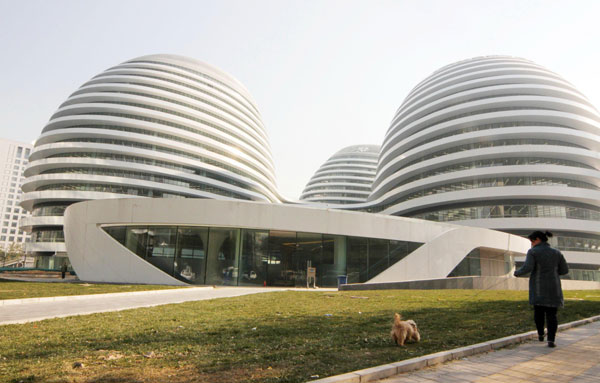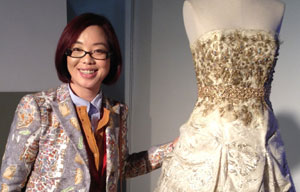East meets West on drafting table
Updated: 2013-04-15 15:10
By Kelly Chung Dawson (China Daily)
|
|||||||||||
 |
|
Wangjing Soho development by British architect Zaha Hadid is a landmark project in Beijing. Wu Changqin / for China Daily Wen Bao / for China Daily |
Western architectural firms in China are finding steady work and more leeway for creative design, but cultural clashes and misunderstandings with local developers remain challenges. Kelly Chung Dawson reports from New York.
When news broke in late 2012 that developers in Chongqing were building a near exact duplicate of British architect Zaha Hadid's Wangjing Soho development in Beijing, her reaction was surprisingly magnanimous.
"That could be quite exciting," she said of the potential for another developer to add innovation or improve upon her work. Soon afterward, her firm issued a threat of litigation against the developer, Chongqing Meiquan, which denied the allegation and launched an advertising campaign proclaiming: "Never meant to copy, only want to surpass".
The Chongqing structure is scheduled to be completed in 2014, a deadline that has both the alleged copycat and its inspiration racing to finish construction first.
Hadid is one of a number of high-profile Western architects commissioned to work on splashy Chinese projects, including state-of-the-art entertainment and arts complexes, airports and luxury hotels across the country. Completed in 2010, Hadid's Guangzhou Opera House employs a revolutionary asymmetrical design. Rem Koolhaas' head-turning design for Beijing's CCTV building, completed in 2008, was labeled "maybe the greatest work of architecture built in this century" by the New York Times.
Less reported has been the wave of small- to mid-sized Western architectural firms that have found steady business designing less glamorous projects such as multi-use retail and business centers, private residences and other structures, feeding a demand for growth and construction in lower-tier cities.
Many US firms also say they have more leeway in China to experiment with creative design than in their risk-averse home market, which has been slow to recover from the economic recession.
Chinese developers choose to contract Western architectural firms for a variety of reasons, most notably the prestige a Western name can bring to a Chinese development. For Western firms, high-paying splashy projects are also enticing.
"Obviously there's the market, and the prestige of doing work internationally," says Kevin Kudo-King of Olson Kundig Architects, a mid-sized firm based in Seattle. "We like being an international firm. And from a selfish point of view, we do feel that doing international work makes our work better."
To Alexander Wong, a Hong Kong-born architect who studied at Princeton University and has worked with Western firms on several projects in China, the question should be: "Why do so many developers all over the world still turn to Western architecture and design firms?".
"Western civilization invented modern architecture, which made a tremendous impact on the course and history of modern civilization, particularly with respect to the development of global urbanism," says Wong, whose projects include the "avant garde cinema" UA Shenzhen, which received a USA International Design Award in 2010. "So perhaps it may not be that much of a surprise that the 'inventors' have at least a slight advantage."
|
|
|
| Dior's 30-minute encore | Summer comes early to Shanghai |
Related Stories
Architecture and food in Argentine wineries 2012-12-17 11:57
Colorful architecture? He's got a bright idea! 2012-10-14 09:35
Architectures in Shanghai 2012-10-08 14:58
Architecture fraternity mourns Luo's death 2012-05-21 10:15
Museum architecture 2012-04-13 10:36
Today's Top News
Police continue manhunt for 2nd bombing suspect
H7N9 flu transmission studied
8% growth predicted for Q2
Nuke reactor gets foreign contract
First couple on Time's list of most influential
'Green' awareness levels drop in Beijing
Palace Museum spruces up
Trading channels 'need to broaden'
Hot Topics
Lunar probe , China growth forecasts, Emission rules get tougher, China seen through 'colored lens', International board,
Editor's Picks

|

|

|

|

|

|







